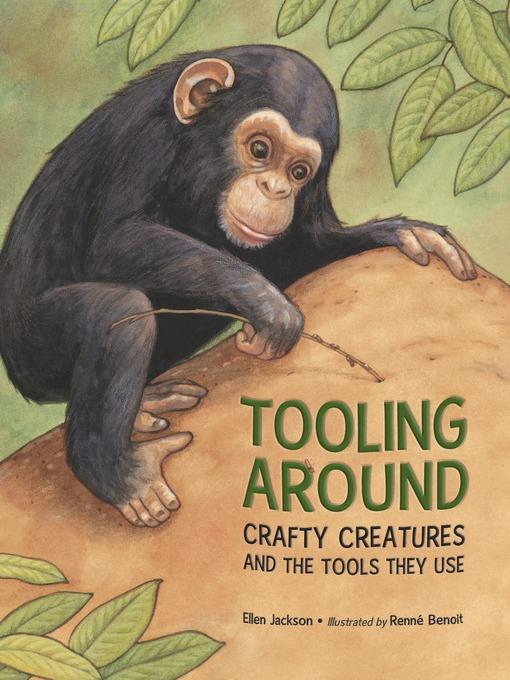
Tooling Around
Crafty Creatures and the Tools They Use
فرمت کتاب
ebook
تاریخ انتشار
2014
Lexile Score
1050
Reading Level
3
ATOS
4.9
Interest Level
K-3(LG)
نویسنده
Renne Benoitناشر
Charlesbridgeشابک
9781607347514
کتاب های مرتبط
- اطلاعات
- نقد و بررسی
- دیدگاه کاربران
نقد و بررسی

August 4, 2014
Upbeat, if somewhat corny rhymes help introduce ways in which 11 wild animals utilize tools. Subjects include a crow that bends a piece of wire to reach an object, otters that use rocks to smash open shellfish, and dolphins that use sea sponges to catch fish: “Dolphins choose a cone-shaped sponge,/ wrap their beaks, then fish and lunge.” Longer prose passages elaborate on each animal’s activity: “Elephants strip leaves from branches,” writes Jackson. “They use the stripped branches to swat flies or other insects that bite them.” Benoit’s mixed-media illustrations fall
between naturalistic and cozy, creating an accessible entry point to learning about animal behavior. An author’s note provides additional background on animals’ tool use and the habitats of the featured animals. Ages 4–8.

October 1, 2014
K-Gr 3-Woodpecker finches, chimpanzees, otters, deer, and octopuses are just some of the animals whose use of tools is explored in this attractive, informational picture book. Rhyming couplets paired with explanatory paragraphs in succinct, descriptive prose explain how various species use objects to accomplish specific goals. A helpful introduction explains what a tool is, defining it fairly broadly ("Many scientists who study animal tool use define a tool as an object that an animal uses to accomplish a goal"): the book uses some clear examples (a chimp using sticks and straws to obtain termites, otters using rocks to crack shells) as well as less obvious ones (squirrels kicking rocks and sand at a snake, male red deer covering their antlers with mud or grass to attract mates). Soft watercolor, pencil, and gouache illustrations depict the animals realistically. This book allows for a rich, up-close look at a fascinating aspect of animal behavior, and while the use of tools is the primary focus, the pictures will also enhance discussions around animal habitats as well. The rhyming portions make this title ideal for reading aloud with younger children, while the more in-depth explanations allow for engaging independent reading by older kids. An author's note goes into further detail about tools, and the bibliography and additional resources showcase some solid books and websites for kids. Useful for instructional purposes and accessible enough for students to read on their own.-Whitney LeBlanc, Staten Island Academy, NY
Copyright 2014 School Library Journal, LLC Used with permission.

July 15, 2014
The use of tools by nonhuman animals is explored via 11 animals, each with its own watercolor portrait, rhymed couplet and explanatory gloss.Unfortunately, in the attempt to rhyme, most of the couplets fail to be clear or memorable. Even the prose is not always clear, as in "Elephants strip leaves from branches. They use the stripped branches to swat flies or other insects that bite them." (Are the "other insects" attacking the flies or the elephants?) The author's note is equally difficult to read, perhaps attempting, but failing, to adapt to beginning readers. Probably the best verse-and also the most whimsical art-is this: "Here's a deer who's quite well dressed, / wearing grass to look his best." The single sentence that follows adds, anthropomorphically, "Male red deer smear their antlers with mud or grass to appear bigger and fiercer to other males and more attractive to females." The sturdy stag is staring into the distance, its antlers interlaced with ferns and grasses. Depictions of flora and fauna show excellent composition and promising, if overworked, artistry, but at the book's beginning and end, awkward paintings of children sadly match dismally unimaginative verses: "Tools help us everywhere, / on the earth and in the air." Alas: Where are the limericks of yore, with the pelican whose "bill can hold more than his belican"?The layout and concept deserve better material. (author's note, list of animals' habitat ranges, resources for children, bibliography) (Informational picture book. 4-8)
COPYRIGHT(2014) Kirkus Reviews, ALL RIGHTS RESERVED.

November 1, 2014
Preschool-G Sure, people use tools, but animals? On each double-page spread of this attractive picture book, Jackson introduces a species that will surprise readers with its inventiveness and adaptability. Short, rhyming verse introduces the ideas, while a large-scale picture illustrates them, and a few sentences explain what the animal is doing and why. For example, the rhyme Otters on an ocean swell / use a rock to crack a shell accompanies images of otters swimming, picking up a rock, and dining on the mollusk inside, while the short prose text comments on what's happening. Also featured are a woodpecker finch, chimpanzee, crow, deer, bowerbird, empid fly, dolphin, octopus, elephant, and squirrel. An author's note discusses scientists' ongoing discussion of animal tool use. Benoit's appealing artwork, created with watercolor, colored pencil, and gouache, illustrates the animals' unusual behaviors with warmth, color, and attention to detail. An intriguing idea presented in an accessible way.(Reprinted with permission of Booklist, copyright 2014, American Library Association.)

























دیدگاه کاربران